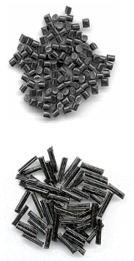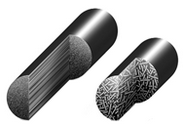LFT Long Fiber Reinforced Thermoplastics
Thermoplastics > Organics polymers
| LFT Long Fiber Reinforced Thermoplastics | |
The difference between the LFRT and compounds with short glass fibers is the fiber length. Compounds of long fiber are the top of the structural performance thermoplastic injection moldable. Fiber Thermoplastics (LFT) are innovative structural products reinforced with long fibers for applications that can replace metals and semi-structural applications. The high characteristics of mechanical performance composite long fiber are the reason often selected as substitutes for metals, as a replacement for plastic underperforming or as alternatives to engineering polymers higher cost by plastics engineering Low cost.It allows to achieve the maximum performance, design freedom, integration of functions, weight reduction and cost savings by piece through fast cycle times. No other method to strengthen melt processable thermoplastics can match its performance crucial properties. LFT function is to create, during the injection molding process, a network of long glass fiber entangled 3D unique within the molded part (shown below). This network of fiberglass actually forms a strong fiber skeleton, which ensures optimum dimensional stability and significantly improves the thermomechanical properties compared to traditional plastic highly filled with short fiber. |  |
| The advantages of long fiber reinforced thermoplastics | |
|  |
| Long fiber reinforced thermoplastics range products | |
In Mexpolimeros we offer a wide range TPU and compounds developed according to their needs, ensuring quality products and service. Our product range includes reinforced composite long fiber combined with all types of continuous fiber (glass, carbon or specialty) in any matrix thermoplastic polymer (PP, PA, etc.) to meet its performance requirements. |  |
| Fiber glass | |
The weight is relatively low compared with the metals (50-70% less) the reduced cost, while the chemical inertness and the values of linear thermal expansion comparable to those of metals, the flexibility during design forms, thanks to the versatility of the injection process and overmolding, processes cheaper production, even from the standpoint of energy, flexibility and resilience of the various solutions (change of polymer and the type and amount load), the use of molding machines traditional plastic, absence of corrosion phenomena in dyeability mass complete the picture of the simplicity of molding and recyclability. |  |
| Fiber reinforced thermoplastic composites | |
The LFTR are created using pultrusion process, where continuous fiber strands impregnated with resin reinforcing plastic and are cut to length directed granulate typically 8 ÷ 10 mm. These materials are reinforced with fibers, whose length corresponds to the length of the granulate. Polypropylene is most common for the thermoplastic, but others such as PET, PBT and PA can be used to impart various properties to the part. We can help you select the most advantageous for thermoplastic application. |  |
| How to mold long fiber reinforced thermoplastics | |
The long fiber reinforced thermoplastics will gain ground to the metal and are easier to process through traditional processing methods. The thermoplastic molding long fiber is a new technology where the thermoplastic material consists directly with long glass fibers (rovings) and then molded in a single operation. The equipment used for molding compounds with short fibers can be used to mold long fibers. The length of the fiber contained in the pellet LFRT contributes to increased mechanical properties, e.g.n order to maintain the length of the fibers during molding, should take into account three factors: the injection machine, the design of the part and the mold and the processing conditions. The part must be designed with a constant wall thickness, preferably in its entirety l os injection points must have a minimum thickness of 2mm (0.080 inches). |  |
| Applications | |
Drivetrain components under the hood automotive body and to reduce weight and reduce fuel consumption. In addition, the old metal products consisting of several parts often can be consolidated into a single net shape to reduce assembly costs. Structural industrial applications such as pumps housing, supports and structural components, allowing greater design freedom, lower weight for lower power requirements and the ability to consolidate parts |  |
